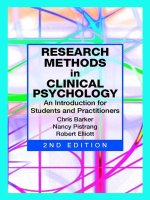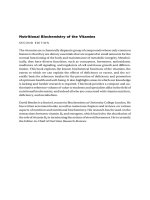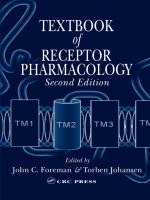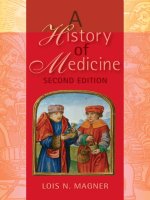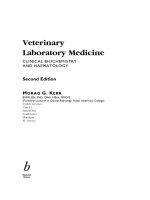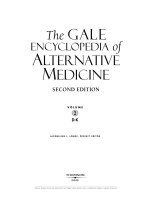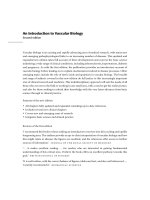CRC Desk Reference of Clinical Pharmacology SECOND EDITION doc
Bạn đang xem bản rút gọn của tài liệu. Xem và tải ngay bản đầy đủ của tài liệu tại đây (38.57 MB, 822 trang )
CRC Press
Taylor & Francis Group
6000 Broken Sound Parkway NW, Suite 300
Boca Raton, FL 33487-2742
© 2008 by Taylor & Francis Group, LLC
CRC Press is an imprint of Taylor & Francis Group, an Informa business
No claim to original U.S. Government works
Printed in the United States of America on acid-free paper
10 9 8 7 6 5 4 3 2 1
International Standard Book Number-10: 1-4200-4743-4 (Hardcover)
International Standard Book Number-13: 978-1-4200-4743-1 (Hardcover)
is book contains information obtained from authentic and highly regarded sources. Reprinted material is quoted with permission, and sources are
indicated. A wide variety of references are listed. Reasonable efforts have been made to publish reliable data and information, but the author and the
publisher cannot assume responsibility for the validity of all materials or for the consequences of their use.
No part of this book may be reprinted, reproduced, transmitted, or utilized in any form by any electronic, mechanical, or other means, now known or
hereafter invented, including photocopying, microfilming, and recording, or in any information storage or retrieval system, without written permission
from the publishers.
For permission to photocopy or use material electronically from this work, please access www.copyright.com ( or contact
the Copyright Clearance Center, Inc. (CCC) 222 Rosewood Drive, Danvers, MA 01923, 978-750-8400. CCC is a not-for-profit organization that provides
licenses and registration for a variety of users. For organizations that have been granted a photocopy license by the CCC, a separate system of payment
has been arranged.
Trademark Notice: Product or corporate names may be trademarks or registered trademarks, and are used only for identification and explanation with-
out intent to infringe.
Library of Congress Cataloging-in-Publication Data
Ebadi, Manuchair S.
Desk reference of clinical pharmacology / author, Manuchair Ebadi. 2nd ed.
p. ; cm.
Rev. ed. of: CRC desk reference of clinical pharmacology / Manuchair Ebadi. c1998.
Includes bibliographical references and index.
ISBN-13: 978-1-4200-4743-1 (hardcover : alk. paper)
ISBN-10: 1-4200-4743-4 (hardcover : alk. paper)
1. Clinical pharmacology Handbooks, manuals, etc. I. Ebadi, Manuchair S. CRC desk reference of clinical pharmacology. II. Title.
[DNLM: 1. Pharmaceutical Preparations administration & dosage Handbooks. 2. Drug erapy Handbooks. 3.
Pharmacokinetics Handbooks. 4. Pharmacology, Clinical Handbooks. QV 735 E15d 2007]
RM301.12.E23 2007
615’.1 dc22 2007010014
Visit the Taylor & Francis Web site at
and the CRC Press Web site at
Dedication
This book is humbly and reverently dedicated
to the honored memory of my beloved parents,
Ali Ebadi Shahmirzadi and Rogieh Djavadi Ebadi Shahmirzadi.
In books lie the soul of the whole past time, the articulate audible voice of
the past when the body and material substances of it has altogether
vanished like a dream.
Thomas Carlyle
VII
C
ONTENTS
Preface to the First Edition ix
Preface to the Second Edition xi
Acknowledgments for the Second Edition xv
Notice xvi
The Author xvii
How to Use This Book xix
List of Orientation Articles xxi
List of Tables xxiv
List of Figures xxv
Chapter 1
The Pharmacokinetic Basis of Therapeutics 1
Chapter 2
The Pharmacodynamic Basis of Therapeutics 17
Chapter 3
Adverse Reactions and Drug–Drug Interactions 21
Chapter 4
Herb–Drug Interactions 23
Chapter 5
Food–Drug Interactions 31
Alphabetical Presentation of Drugs 35
Index 745
IX
P
REFACE TO THE
F
IRST
E
DITION
Hippocrates (460–377 B.C.) lamented, “Life is short, and
the art long; the occasion fleeting; experience fallacious;
and judgment difficult.” New drugs and novel avenues of
treatment are emerging rapidly, requiring constant vigilance
to remain informed.
The CRC Desk Reference of Clinical Pharmacology,
designed and prepared specifically for physicians and other
members of the health-care delivery team, contains more
than 2000 entries appearing under three broad categories:
I. Short reviews (1%) dealing with important topics of
clinical pharmacology such as the pharmacokinetic basis of
therapeutics, pharmacodynamic principles, and drug–drug
interactions. In addition, major areas of therapeutics such
as antiemetic drugs, antihistaminics, calcium channel
blocking agents, and nonsteroidal antiinflammatory agents
have been reviewed. The diagrams and tables not only cover
major areas of therapeutics but also deal with multiple med-
ications. For example, Table 1 summarizes the pharmaco-
logical properties of acetohexamide, chlorpropamide,
glipizide, glyburide, tolazamide, and tolbutamide, the orally
effective hypoglycemic agents. Table 2 summarizes the
analgesic, antipyretic, antiinflammatory, and uricosuric
properties of all nonsteroidal antiinflammatory agents.
Figure 1 deals with pharmacokinetic principles such as
absorption, distribution, tissue binding, biotransformation,
and elimination of drugs. Figure 2 deals with 5-fluorouracil,
dacarbazine, cytarabine, methotrexate, vincristine, vinblas-
tine, bleomycin, actinomycin D, and doxorubicin exerting
their effects at G
1
phase, S phase, G
2
phase, and miotic
phase of the cell cycle, respectively.
II. Abstract-length entries (39%) providing a short
description of every medication in use today.
III. Short dictionary-style entries (60%) describing in
one sentence the exact therapeutic use of a medication. For
example: “Halcinonide, a topical adrenocorticoid with anti-
inflammatory properties is indicated in inflammation of
acute and chronic corticosteroid-responsive dermatoses.”
Each entry gives the name of the drug, its classification,
its dosage, its indications, its mechanism of action, its phar-
macokinetic properties if appropriate, its side effects, and its
signs and symptoms of overdosage. The section on pharma-
cokinetics has been designed to be meaningful in nature. For
example, if a drug is mainly eliminated unchanged, it is noted
that its dose should be adjusted downward in renal failure.
Another unique feature of the book is that items of infor-
mation have been given in a comprehensive fashion. For
example, Table 21 provides information to be used in the
treatment of hypertensive emergics. This includes provision
of pharmacological properties of sodium nitroprusside, dia-
zoxide, labetalol, nitroglycerin, phentolamine, trimethaphan,
hydralazine, and nicardipine. All these drugs have their own
separate entries but have also been assembled in a mean-
ingful fashion in one place.
The author expresses his heart-felt appreciation and grat-
itude to Professor Gerald A. Kerkut of the University of
Southampton and David Grist of CRC Press LLC for the
confidence rendered and for the kind invitation to prepare
a volume on clinical pharmacology. Their valuable guid-
ance, direction, and support have been immense and are
gratefully acknowledged.
The author also acknowledges the contribution of the
members of the international advisory board in the process
of designing, writing, and completing this desk reference.
They are:
Thomas E. Andreoli, M.D.
Professor and Chairman
Department of Medicine
University of Arkansas
College of Medicine
Little Rock, Arkansas
Ronald F. Pfeiffer, M.D.
Professor of Neurology
Director, Division of Neurodegenerative
Disease
University of Tennessee
College of Medicine
Memphis, Tennessee
Franco Frashini, M.D.
Director
Department of Pharmacology
and Chemotherapy
University Degli Studi di Milano
Milan, Italy
Alan C. Sartorelli, Ph.D.
Alfred Gilman Professor
of Pharmacology and
Epidemiology
Yale University School
of Medicine
New Haven, Connecticut
Alfred M. Freedman, M.D.
Professor and Chairman of Psychiatry
Director of Psychiatric Service
Metropolitan and Flower and Fifth
Hospitals and Chairman, Department
of Psychiatry, Grasslands Hospital
Valhalla, New York
Arnold Schwartz, Ph.D.
Professor and Chairman
Department of Pharmacology and Cell
Biophysics
University of Cincinnati
College of Medicine
Cincinnati, Ohio
X PREFACE TO THE FIRST EDITION
The author also expresses his everlasting admiration to
Margaret McCall and to Lori Ann Clapper for their mag-
nificent dedication, uncompromising diligence, and compe-
tent skills in typing the entire manuscript, and to John
Enrique Mata for designing and drawing the art work. The
exceptional and rare talent, skills, and expertise of Gail
Renard, the project editor, and Kathy Johnson, the typesetter,
in refining this volume, are gratefully and respectfully
acknowledged. Thanks are also due to Cindy Carelli,
Carolyn Lea, Julie Haydu, and Becky McEldowney—all of
CRC—for their help and professionalism.
The author hopes that by providing simple and unique
diagrams, comprehensive tables, and more than 2000
entries, the CRC Desk Reference of Clinical Pharmacology
will become a valuable and essential reference book for
physicians and other members of the medical profession in
their quest to alleviate the mental and physical sufferings
of their fellow human beings.
M. Ebadi
Omaha, Nebraska
July 1997
Robert H.
Handschumacher, Ph.D.
Professor Pharmacology
Yale University School of
Medicine
New Haven, Connecticut
Howard M. Spiro, M.D.
Department of Internal Medicine
Yale University School of Medicine
New Haven, Connecticut
Elliot S. Vesell, M.D.
Evan Pugh Professor and Chairman
Department of Pharmacology
Pennsylvania State University
College of Medicine
Hershey, Pennsylvania
XI
P
REFACE TO THE
S
ECOND
E
DITION
Since publication of the first edition of CRC Desk Reference
of Clinical Pharmacology in 1998, dramatic discoveries in
molecular medicine, along with rapid concomitant tech-
nological advances, have revolutionized the diagnosis and
treatment of a broad range of human diseases with new
medications. Given the rapid pace of new discovery,
genetic- and cell-based therapeutics have now become a
common part of the physicians’ armamentarium. A few
examples will be given concerning two leading causes of
death—cancer and cardiovascular diseases—to illustrate this.
At the midpoint of the 20th century, our knowledge of
cancer was based on epidemiology and pathology, and treat-
ment consisted of surgery and radiation therapy. More mod-
ern views on carcinogenesis favor a genetic cause for
cancer. The incidence of cancer increases sharply with age,
and various models have been proposed to account for this
increase. The human immune system can mount a specific
response to cancer. Intense research is aimed at dissecting
the intricacies of the interaction between the immune sys-
tem and tumor cells.
A driving force behind this research is the idea that
cancer-directed immunity can be enhanced to improve the
outcome for patients with the disease. The specificity of the
immune response makes cancer immunotherapy extremely
effective because it offers the promise of reducing damage
to the bystander normal tissues and lessening the severe
side effects associated with cancer therapies. Another mod-
ern treatment is monoclonal antibodies, which exhibit a
favorable pharmacokinetic profile. Pharmacokinetic vari-
ability among patients is low, which helps ensure that all
patients receiving a given dose achieve appropriate expo-
sure to the drug. Unlike many therapeutics now used in
cancer patients, monoclonal antibodies are not subject to
metabolic drug–drug interactions and are not substrates of
the multidrug-resistant efflux pumps. The third example of
emerging molecular therapeutics in cancer patients is drugs
interfering with signal transduction pathways. Signal
transduction describes the processes involved in the com-
munication between the cell and its environment, and in the
regulation of cell fate. These pathways are commonly
hijacked by the genomic abnormalities that drive malignant
progression. Proof of principle has now been established
that targeting signal transduction pathways can be clinically
beneficial. Tackling multistep carcinogenesis will most
likely require combinatorial therapies: probably cytotoxic
plus a signal transduction inhibitor. The fourth example of
the molecular therapeutics in cancer patient is suicide gene
therapy. The possibility of rendering cancer cells more
sensitive to drugs or toxins by introducing suicide genes
has two alternatives: toxin gene therapy, in which the genes
for toxic products are transformed into tumor cells, and
enzyme-activating prodrug therapy, in which the transgene
encodes an enzyme that activates specific pro-drugs to
create toxic metabolites. The latter approach, as well as
suicide gene therapy and gene-directed enzyme prodrug
therapy (GDEPT), has also been termed virus-directed
enzyme prodrug therapy and gene prodrug activation
therapy.
The cardiovascular diseases potentially amenable to
gene therapy include:
The second edition of the CRC Desk Reference of Clinical
Pharmacology is designed specifically for physicians, phar-
macists, nurses, and other members of the health care deliv-
ery team. It consists of three parts.
Part One: The book still has brief, concise, and infor-
mative A–Z drug facts from abciximab to zolpidem tartrate.
Part Two: The book again presents some very novel and
exciting entries not seen in any existing textbooks of phar-
macology. These items will include, but not be limited to,
the items listed below.
DRUG METABOLISM AND TRANSPORT
Two key aspects of how the body handles drugs and other
chemicals are metabolism and transport. Metabolism is crit-
ical because it enables the body to process highly lipophilic
molecules for further metabolism and eventual excretion,
inactivates biologically active molecules, or detoxifies poten-
tially toxic chemicals. Transport processes are critical
because they determine the ability of drugs and other chem-
icals to gain access to sites of metabolism or to physiological
or toxicological targets within tissues. The remarkable
advances in molecular and cell biology and the development
of novel in vitro model systems to study the various processes
involved in metabolism and transport have expanded our
knowledge and led to numerous new therapeutic approaches
to the treatment of chemically induced toxicity and disease.
Familial hypercholesterolemia
(LDL receptor
defective/absent)
LDL clearance
Dyslipidemia with no specific
genetic defect
LDL clearance
Hypertension Increase in HDL
Peripheral artery disease Angiogenesis
Occlusive arterial disease Cytostatic, cytotoxic, inhibition of
smooth muscle cell proliferation
Thrombosis Decreased thrombus formation,
increased fibrinolysis
Hypertrophic cardiomyopathy Normalized sarcomere function
Ischemic heart disease Angiogenesis
Heart failure Improved calcium handling,
increased contractility
Cardioprotection Adiopectin
XII PREFACE TO THE SECOND EDITION
PHARMACOGENOMICS
Pharmacogenomics exists at the intersection of pharmacol-
ogy and genomics. It aims to study the genetic basis of
interpatient variability in response to drug therapy. Pharma-
cogenomics holds the promise that drugs may eventually
be tailor-made for individuals and adapted to each person’s
genetic makeup. Environment, diet, age, lifestyle, and the
disease state can all influence a patient’s response to med-
icines, but understanding an individual’s genetic makeup is
thought to be the key to creating personalized drugs with
greater efficacy and safety. Pharmacogenomics combines
traditional pharmaceutical sciences with knowledge of
genes, proteins, and single nucleotide polymorphisms. Our
discussion will focus on the various technologies currently
available and stress that researchers must be able to choose
the technology best suited to their purposes.
ANTISENSE THERAPEUTICS
The recently completed sequencing of the human genome
has demonstrated the presence of a vast number of targets
for antisense oligonucleotides. So we now have thousands
of targets, hundreds of preclinical animal studies, and some
20 clinical trials ongoing. Any successful trial with an anti-
sense compound will open a floodgate of new therapies for
a panoply of diseases.
THE MANAGEMENT OF EATING DISORDERS
AND OBESITY
There is increasing awareness about eating disorders and
their predispositions. Efforts are expanding on prevention,
early identification, and intervention in eating disorders.
Clinicians are developing treatment strategies incorporating
newer technologies including the Internet, which might
eventually reduce costs while improving access to, and
effectiveness of, therapy. Regarding obesity, the greater
focus is on prevention, and strategies for prevention are
being evaluated. Researchers are identifying the effects of
maternal behaviors during pregnancy that “imprint” the
fetus for increased postnatal weight gain and obesity-asso-
ciated disease complications. As we learn about such effects,
we may be able to recommend behaviors for pregnant women
that would reduce the future risk for their infants.
PREVENTIVE NUTRITION
Preventive nutrition incorporates dietary practices and inter-
ventions directed toward the reduction of disease risk (pri-
mary prevention), improvements in disease states already
manifest (secondary prevention), and improvement in
health outcomes. Preventive nutrition is a critical compo-
nent not only of preventive medicine, but also of therapeutic
medicine and provides approaches for preventing disease
and reducing its impact once it occurs.
ADOPTIVE IMMUNOTHERAPY
Over the last decade, advances in cellular and molecular
immunology have been tremendous. Our continuously
improving understanding of the immune system and the
appreciation of the mechanisms by which tumors and viral
or bacterial infections are controlled have led to promising
new treatment strategies. Adoptive transfer of tailored anti-
gen-specific immune cells and or optimally designed immu-
nological effector molecules is an elegant and promising
approach to the establishment or restoration of protective
immune responses.
CANCER CHEMOPREVENTION
Despite significant advances in cancer treatment and early
detection, overall cancer incidence has increased, cancer-
associated morbidity is considerable, and overall cancer
survival has remained relatively flat over the past several
decades. However, new technology allowing exploration of
signal transduction pathways, identification of cancer-
associated genes, and imaging of tissue architecture and
molecular and cellular function is increasing our under-
standing of carcinogenesis and cancer progression. This
knowledge is moving the focus of cancer therapeutics,
including cancer-prevention treatments, to drugs that take
advantage of cellular control mechanisms to selectively sup-
press cancer progression.
DRUG DELIVERY SYSTEMS IN CANCER
THERAPY
The use of drug delivery systems to improve the efficacy of
cancer chemotherapy remains an important strategy for
achieving progress against this disease. Over the past 20 years,
the number of novel therapeutic approaches has expanded
from traditional small chemical medicinals to a wide variety
of biomolecules, including peptide/protein- and nucleic acid-
based therapeutics. All of these therapies require the admin-
istration of stable dosage forms in adequate concentrations
and exposure periods to realize their potential. For the treat-
ment of many forms of cancer, the presentation and mainte-
nance of adequate drug concentrations to the target tissues
without exposure to drug-sensitive normal tissues are the
major limitations for successful chemotherapy.
IMMUNOTHERAPY OF CANCER
Tumor immunology is a scientific discipline that is driven
by clinical translation. For many decades, scientists both at
the bench and at the bedside have struggled with deter-
mining the role immunity may play in tumor eradication,
if an for many years, the major question driving the field
was whether human tumors were immunogenic. Over the
last decade, literally thousands of immunogenic proteins
related to tumors have been identified, resulting in a host
of new targets for immunomodulation.
PROTEASOME INHIBITORS IN CANCER
THERAPY
Inhibition of the proteasome in cultured cells, mostly of
tumor origin, produced profound stabilization of hundreds,
if not thousands, of proteins, ultimately turning on the
PREFACE TO THE SECOND EDITION XIII
programmed cell death machinery at concentrations that
directly correlated to the intrinsic inhibition constant of the
proteasome. Such observations begged further investigation
of proteasome inhibition in the treatment of human cancers.
RECOMBINANT ANTIBODIES FOR CANCER
THERAPY
The purpose of Recombinant Antibodies for Cancer Ther-
apy is to present a collection of detailed protocols in recom-
binant antibody technology. It is primarily addressed to
scientists working on recombinant antibodies as well as
clinicians involved with antibody-based therapies.
SUICIDE GENE THERAPY
The area of gene therapy is vast, and both malignant and
nonmalignant cells can be targeted. Gene therapy that tar-
gets malignant cells in a treatment has become known as
“suicide gene therapy.” Basically, this approach uses the
transduction of cancer cells with a gene for a foreign
enzyme that, when expressed, is able to activate a nontoxic
prodrug into a highly cytotoxic drug able to kill the cancer
cell population
Part Three: Includes short descriptions of conditions,
diseases, and disorders and their treatments. The list
includes but is not limited to the following items:
Acute respiratory distress syndrome; treatment
Adrenergic (sympathomimetic) compounds
Adrenergic (sympathomimetic) receptor blocking
agents
Adrenocorticoids; topical antiinflammatory agents
available as cream, gel, lotion, or ointment
Aged patients; altered pharmacokinetic profile of
Agranulocytosis; drug-induced
Allergic rhinitis
Alzheimer’s disease; treatment of
Aminoglycoside antibiotics
Analgesics; narcotics
Analgesics; non-narcotic agents
Androgenic steroids
Anesthetics; inhalation
Angiotensin-converting enzyme (ACE) inhibitors for
hypertension
Anorexia nervosa and bulimia nervosa; treatment of
Antacids
Antianxiety agents
Antibacterial drugs of choice
Antidepressants
Antidiarrheal medication
Antidiuretic hormone
Antidotes
Antiemetic preparations
Antihistamines (H
1
receptor antagonists)
Antihypertensive medications
Antineoplastic agents
Antiparasitic medications and their side effects
Antipsychotics
Antiviral agents
Arrhythmias
Arthritis and degenerative joint disease; treatment of
Asthma; treatment of
Autonomic receptors
Benzodiazepines; uses of
Beta-adrenergic-receptor-blocking agents
Bioavailability of drugs; factors influencing
Botulinum toxin A; uses of
Bronchodilators; β-adrenergic agonists for the treat-
ment of asthma
Calcium-channel blockers for the treatment
of hypertension
Calcium products
Cephalosporins
Cerebroactive medications
Chlamydial infections; treatment of
Cholinergic drugs; uses in medicine
Cholinergic-receptor-blocking agents; uses of
Cirrhosis; treatment of
Congestive heart failure; treatment of
Constipation; drug-induced
Corticosteroids; uses for
Crohn’s disease; treatment of
Cytokines; their actions
Dermatological disorders; treatment with retinoids
Diabetes mellitus; treatment of non-insulin-depen-
dent cases
Diarrhea; drug-induced
Diuretics
Duodenal ulcers; treatment of
Enzymes and hormones of gastrointestinal tract;
actions of
Epileptic seizures; treatment of
Erectile dysfunction; treatment of
Ergot alkaloids
Estrogenic preparations
Expectorants; drugs that increase respiratory tract fluid
Fungal infections; treatment of
Gastroesophageal reflux disease (GERD);
treatment of
Gaucher’s disease; treatment of
Gene therapy; e.g., for acquired immune deficiency
syndrome (AIDS)
Gilles de la Tourette’s syndrome; treatment of
Glaucoma; treatment for
Gonorrhea; treatment of
Gout; treatment of
Heart failure; treatment of
Hemostatic mechanisms and drugs influencing them
Hiccup; treatment of
Hirsutism; treatment of
Human immunodeficiency virus (HIV) infection;
treatment for
Huntington’s disease; the search for treatment continues
XIV PREFACE TO THE SECOND EDITION
Hyperglycemia; drug-induced
Hypertension; treatment of
Hypertensive emergencies; treatment of
Hypnotics
Hypoglycemia; drug-induced
Hypothalamic hormones
Immunization; agents used in
Immunosuppressive medications
In vitro fertilization; drugs for
Insomnia; treatment with benzodiazepines
Insulin preparations
Iodine-containing products
Ischemic stroke; treatment of
Laxatives
Legionnaires’ disease; treatment of
Lipid-lowering drugs
Local anesthetics
Lower respiratory tract infections; treatment of
Macrolide antibiotics
Manic symptoms; drug-induced
Migraine headaches; treatment of
Monoamine oxidase inhibitors; contemporary
treatment of depression
Multiple sclerosis; treatment of
Myasthenia gravis; treatment of
Mycoses; treatment of deep-seated organisms
Myoclonus; treatment of
Narcolepsy; treatment of
Neurotransmitters and their receptor subtypes
Newborns; undeveloped pharmacokinetic profile
Nitrate products
Nondepolarizing neuromuscular blocking drugs
Nonsteroidal antiinflammatory drugs
Nursing infants; pharmacology of
Obesity; treatment of
Oculotoxicity; drug-induced
Opioid peptides
Opioids; receptor agonists and antagonists
Oral hypoglycemic agents
Orphan drugs; proposed uses of
Osteoporosis; treatment of
Otitis media; treatment of
Ototoxicity; drug-induced
Ovulation; drugs to induce
Pancreatic enzymes preparations
Panic disorder; treatment of
Parasitic infections; treatment of
Parkinson’s disease; treatment of
Penicillins
Peptic ulcer; treatment of
Photosensitivity; medication-induced
Psychiatric symptoms caused by drugs
Psychotropic medications; side effects of
Pulmonary toxicity; drug-induced
Quinolone and fluoroquinolone antibiotics
Radiopaque agents
Restless legs syndrome; treatment of
Retinoids
Seizures; treatment of
Serotonin receptor subtypes
Sexual dysfunction caused by drugs
Sexually transmitted diseases; treatment of
Shingles; treatment of
Sinusitis; treatment of
Stuttering; treatment of
Suicide; prevention of
Sulfonamides
Syphilis; treatment of
Tetracyclines
Thrombolytic agents; a need for improvement
Thyroid preparations
Trace minerals essential for health
Traveler’s diarrhea; prevention of
Tuberculosis; treatment of
Upper respiratory tract infection; treatment of
Urinary tract infections; treatment of
Uveitis; management of
Vaginal candidiasis; treatment of
Vasodilators; effects on cardiac output (CO)
Vitamins; their coenzymatic functions
Vomiting caused by antineoplastic agents
Wilson’s disease; treatment of
Wound infection and sepsis in surgical patients; treat-
ment of
Every attempt has been made to be comprehensive, author-
itative, and accurate in the expanded and improved second
edition of the CRC Desk Reference of Clinical Pharmacology.
The first five chapters present discussions of the Pharmaco-
kinetic Basis of Therapeutics, Concepts of Pharmacody-
namics, and the Principles of Drug–Drug Interactions
and Drug–Food Interactions. Moreover, whenever possi-
ble, the interactions among herbal alternative medicines,
and modern therapeutics have been outlined.
The author expresses his heartfelt appreciation to many
physicians including his son Mark Ebadi, M.D., board cer-
tified in internal medicine from Northwestern University,
Chicago and in allergy and immunology from National Jew-
ish Hospital, Denver, who suggested items for inclusion,
avenues for improvement, and lit the path for writing and
improving this second edition to be used by those healers
who extend the attributes of the Lord Almighty in alleviating
the physical and mental sufferings of their fellow human
beings.
M. Ebadi, Ph.D., FACCP
Grand Forks, North Dakota
XV
A
CKNOWLEDGMENTS FOR THE
S
ECOND
E
DITION
The author expresses his appreciation to Dr. Judith E.
Spiegel, Senior Editor of Life Sciences for CRC Press, for
the gracious invitation to prepare this second edition, and
to Gail Renard, the production editor, for polishing and
refining the book. The author remains eternally grateful and
in awe of Gail’s judgment and titanic contributions to
restructuring and refining five books for him in an admirable
fashion.
The author expresses his loving tribute to his two sons,
John Ebadi, Ph.D. (specializing in Oriental medicine and
Eastern healing art) and Mark Ebadi, M.D. (specializing
in Western medicine and Western healing art), for their
input on how to bridge past and present medical wisdom
and how to respect not only the immense contributions of
many ancient cultures but also the amazing advances made
by physicians today to the well being of human beings in
their quest to prevent disease, prolong life, and reduce
morbidity.
The author remains indebted to Victoria Swift, the
director of the art department at the University of North
Dakota School of Medicine and Health Sciences, for her
ingenuity in design and graphic arts in completing many
of the diagrams.
The author remains beholden to Leah Beth Gustafson,
a Presidential Scholar from the University of North Dakota,
for gathering materials from world literature to prepare this
new edition.
The author also remains beholden to Angela Mae
Williams, a Presidential Scholar from the University of
North Dakota, for editing the typed materials with her eagle
eye and brilliant mind.
The author remains indebted to JoAnn Johnson for
being as dependable as the rising sun and the beating heart
in completing whatever tasks need completion.
The author extends his heartfelt salutation and felicita-
tion to Dani Stramer for her devotion, loyalty, and perfec-
tionism in completing all her obligations in a majestic
fashion. Her dedication, skill, and determination made this
edition a magnificent achievement in therapeutics.
It is with affection and gratitude that the author honors
his teachers and mentors: Carl B. Camras, M.D., Arnold
L. Frizzle, Ph.D., Delta W. Gier, Ph.D., Joseph P.
Gilmore, Ph.D., John M. Hamilton, Ph.D., Thomas Her-
nandez, M.D./Ph.D., Woodbridge O. Johnson, Jr., Ph.D.,
Robert B. Kugel, M.D., Ernest E. McCoy, M.D., Robert
Eli Long, Ph.D., Russell J. Reiter, Ph.D., and Paul M.
Scott, Ph.D., for inspiring him to learn. And he salutes his
students for encouraging him to teach.
The author extends his undying respect to the Honorable
Byron L. Dorgan, U.S. senator from North Dakota, and to
the Honorable John Hoeven, the governor of North Dakota,
for their support and extending arms of friendship whenever
needed in supporting the author’s numerous research programs
at the University of North Dakota.
The author salutes Charles E. Kupchella, Ph.D., president
of the University of North Dakota; Peter Alfonso, Ph.D., vice
president for research, the University of North Dakota; H.
David Wilson, M.D., dean and vice president for health affairs,
University of North Dakota School of Medicine and Health
Sciences, Joshua Wynne, M.D., M.B.A., M.P.H., executive
associate dean, University of North Dakota School of Medicine
and Health Sciences, and Randy Eken, associate dean for
administration and finance, University of North Dakota School
of Medicine and Health Sciences, for confidence displayed in
the author’s talent and supporting him whenever needed.
The author remains humbled and in awe of hundreds of
physicians who read and made the first edition a success
but also reviewed the book, lit the path, and gave direction
on how to write the revised edition.
XVI
NOTICE
The indications and dosages of all drugs in this book have
been recommended in the medical literature and conform to
the practices of the general medical community. The medi-
cations described do not necessarily have specific approval
by the U.S. Food and Drug Administration for use in the
diseases and dosages for which they are recommended. The
package insert for each drug should be consulted for use and
dosage as approved by the PDA. Because standards for usage
change, it is advisable to keep abreast of revised recommen-
dations, particularly concerning new drugs.
XVII
THE AUTHOR
Manuchair Ebadi earned
a B.S. degree in chemis-
try from Park University
(Parkville, MO, 1960), an
M.S. degree in pharma-
cology from the Univer-
sity of Missouri College
of Pharmacy (Kansas
City, 1962), and a Ph.D.
degree in pharmacology
from the University of
Missouri College of
Medicine (Columbia,
1967). He completed his
postdoctoral training in
the Laboratory of Pre-
clinical Pharmacology at the National Institute of Mental
Health (Washington, DC, 1970), under the able direction of
Erminio Costa, M.D., an eminent member of the National
Academy of Sciences.
Dr. Ebadi served as chairman of the Department of Phar-
macology at the University of Nebraska College of Medi-
cine from 1970 until 1988, and subsequently as professor
of pharmacology, neurology, and psychiatry from 1988
through 1999. In July of 1999, he was appointed professor
and chairman of the Department of Pharmacology and Tox-
icology at the University of North Dakota School of Med-
icine and Health Sciences. In September of 1999, Dr. Ebadi
became professor and chairman of the newly created
Department of Pharmacology, Physiology, and Therapeu-
tics; in November 1999, he became professor of neuro-
science; and in December 1999, he was appointed associate
dean for research and program development. In September
2000, Dr. Ebadi was appointed director of the Center of
Excellence in Neurosciences at the University of North
Dakota School of Medicine and Health Sciences, and in
March 2002, associate vice president for medical research
at the University of North Dakota.
During his academic career, Professor Ebadi has
received 36 awards, including the Burlington Northern Fac-
ulty Achievement Award (1987) and the University of
Nebraska’s systemwide Outstanding Teaching and Creative
Activity Award (1995), and was inducted into the Golden
Apple Hall of Fame (1995) for having received 11 Golden
Apple awards from the national Golden Apple Foundation
for excellence in teaching. He is a member of 18 research
and scholarly societies including Alpha Omega Alpha
Honor Medical Society.
In 1976, Dr. Ebadi became the Mid-America State Uni-
versities Association’s (MASUA) honor lecturer; in 1987,
he received an award for “meritorious contributions to
pharmaceutical sciences” from the University of Missouri
Alumni Association; in 1995, he was honored by a resolu-
tion and commendation of the board of regents of the Uni-
versity of Nebraska for having developed a sustained record
of excellence in teaching, including creative instructional
methodology; and in 1996, he received the Distinguished
Alumni Award from Park University, his alma mater. In
November 2002, Dr. Ebadi received a recognition award in
appreciation of his outstanding contribution to the UND
School of Medicine. In May 2003, Dr. Ebadi received the
Outstanding Block Instructor Award for outstanding perfor-
mance “in the encouragement, enrichment, and education of
tomorrow’s physicians.” In 2003, he was elected to the pres-
tigious Cosmos Club (Washington, DC) for individuals who
have distinguished themselves in art, literature, or science.
Professor Ebadi discovered and characterized brain me-
tallothionein isoforms in 1983 and subsequently showed that
they are able to scavenge free radicals implicated in Par-
kinson’s disease. In addition, he showed that metallothio-
nein averts α-synuclein nitration, enhances the elaboration
of coenzyme Q10, increases the activity of complex I,
enhances the synthesis of ATP, and as an antioxidant is 50
times more potent than glutathione. His research programs
have been supported in the past and currently by the
National Institute on Aging (AG 17059-06); the National
Institute of Environmental Health Sciences (NIEHS 03949);
the National Institute of Child Health and Human Devel-
opment (NICHD 00370); the National Institute of Neuro-
logical Disorders and Stroke (NINDS 08932, NINDS
34566, and NINDS 40160); and the Office of National Drug
Control Policy, Counter Drug Technology Assessments
Center (DATM 05-02-C-1252).
Professor Ebadi has written ten books. The Pharmacology
text was translated into Japanese in 1987 (Medical Science
International Ltd., Tokyo); the Core Concepts in Pharmacol-
ogy was translated into Chinese in 2002 (Ho-Chi Book Pub-
lishing of Taiwan); and the Pharmacodynamic Basis of
Herbal Medicine (CRC Press, 2002) became a best seller.
In 2005 Dr. Ebadi, along with Professor Ronald F. Pfeiffer,
M.D., published a book entitled Parkinson’s Disease, which
received excellent reviews in JAMA (293, 2281, 2005), and
in the New England Journal of Medicine (352, 1304, 2005),
and won first prize in the neurology category of the 2006
British Medical Association’s Book Competition.
On February 26, 2004, Dr. Ebadi received the University
of North Dakota Foundation’s Thomas J. Clifford Faculty
Achievement Award for Excellence in Research and, on
September 7, 2004, he received from President Charles E.
Kupchella, the designation of Chester Fritz Distinguished
Professor of Pharmacology and of Clinical Neuroscience, the
highest honor bestowed by the University of North Dakota.
XVIII THE AUTHOR
On July 21, 2005, Dr. Ebadi received the Pendelton
Honor from Eugene DeLorme, J.D., director of Indians into
Medicine Programs; from Dr. David Gipp, president of
United Indian Nations; and from Dr. Frank Williams, vice
president of the tribal board in appreciation of his providing
research support for the Indian nations. Dr. Ebadi has served
as a member of the United States Pharmacopoeia conven-
tion since 1970. On March 2, 2006, Dr. Ebadi was appointed
senior advisor to the president of the University of North
Dakota.
XIX
HOW TO USE THIS BOOK
This book may be used as an encyclopedia of medications
in which compounds appear under their generic names in
alphabetical order from Abacavir sulfate, to Zopiclone, the
first compound of the cyclopytolone class possessing anti-
convulsant, anxiolytic, muscle relaxant, and sedative prop-
erties. Furthermore, in the index, all drugs, including their
generic names and multiple trade names, appear in alpha-
betical order.
This book may also be used as a textbook with its
introductory materials such as the pharmacokinetic basis
of therapeutics, the pharmacodynamic basis of therapeu-
tics, and adverse reactions and drug–drug interactions,
which have been presented in a review format. In addition,
many important and often-used medications (for example,
androgens, antacids, antiemetic agents, antihistamines,
barbiturates, benzodiazepine derivatives, calcium-channel
blockers, cathartics, cephalosporins, chemoprotectants,
corticosteroids, cytokines, digitalis, folic acid antagonists,
general anesthetics, insulin preparations, iron prepara-
tions, laxatives, levodopa–carbidopa, nitrates–nitrites,
penicillins, salicylates and allied medications, tetracyclines,
thiazide diuretics, and vitamins) have been described in
detail. The tables and figures summarize and illustrate in
an attractive fashion information about major areas of
therapeutics. In addition, medications have been covered
under multiple headings to make the search for them sim-
ple and to make their descriptions informative. For exam-
ple, aspirin is found in the sections on acetylsalicylic acid,
nonsteroidal antiinflammatory agents, and salicylates and
allied compounds.
The orientation articles, which the reader will find
enclosed in boxes throughout the text, summarize the
treatment of common disorders/diseases including
Alzheimer’s disease, arrhythmias, arthritis, asthma, conges-
tive heart failure, constipation, Crohn’s disease, duodenal
ulcer, erectile dysfunction, fungal infections, Gaucher’s dis-
ease, Gilles de la Tourette syndrome, glaucoma, gonorrhea,
gout, heart failure, human immunodeficiency virus (HIV)
infection, Huntington’s disease, hypertension, insomnia,
Legionnaires’ disease, mania, migraine, multiple sclerosis,
mycoses, narcolepsy, obesity, osteoporosis, otitis media,
panic disorder, parasitic infections, Parkinson’s disease,
peptic ulcer, seizure disorders, sinusitis, syphilis, upper res-
piratory tract infections, urinary tract infections, uveitis,
vaginal candidiasis, and Wilson’s disease.
Orientation articles provide an encyclopedic listing of
medications dealing with aminoglycoside antibiotics,
analgesics, androgens, angiotensin-converting enzyme
inhibitors, antianxiety agents, antibacterial drugs, antide-
pressants, antidiarrheal medications, antidotes, antiemetics,
antipsychotics, antiviral agents, diuretics, estrogen prepara-
tions, expectorants, laxatives, lipid-lowering drugs, orphan
drugs, radiopaque agents, sulfonamides, tetracyclines,
thrombolytic agents, and many others.
In many cases, newly introduced medications, such as
the use of melatonin for sleep disorders, have been included.
Discussion of some novel medications, such as tizanmidine
for the treatment of spasticity or urapidel for the treatment
of hypertension, has been provided. Discussion of the rap-
idly growing family of peptides, such as trefoil peptides,
with a possible healing factor for peptic ulcers and inflam-
matory bowel diseases, and many other novel avenues of
therapeutics have been introduced. Whenever possible, the
descriptions of medications have been given in concise form
and in a nugget fashion.
XXI
LIST OF ORIENTATION ARTICLES
Acute respiratory distress syndrome 45
Aged patients: Altered pharmacokinetic profile 50
Agranulocytosis: Drug-induced 51
Allergic rhinitis 55
Alzheimer’s disease 58
Analgesics 71
Angiotensin-converting enzyme (ACE) inhibitors for hypertension 73
Anorexia nervosa and bulimia nervosa 73
Antacids 74
Antianxiety agents 74
Antibacterial drugs of choice 75
Antiemetic preparations 82
Antihistamines (H
1
-receptor antagonists) 84
Antihypertensive medications 84
Antineoplastic agents 84
Antiparasitic medications and their side effects 85
Antipsychotics 86
Antiviral agents 87
Arrhythmias 88
Arthritis and degenerative joint disease 89
Asthma 91
Autonomic receptors 95
Benzodiazepines 103
Beta-adrenergic-receptor-blocking agents 105
Bioavailability of drugs 107
Botulinum toxin A 110
Bronchodilators: β-adrenergic agonists for the treatment of asthma 113
Calcium-channel blockers for the treatment of hypertension 120
Cephalosporins 143
Cerebroactive medications 144
Chlamydial infections 146
Cholinergic drugs 153
Cholinergic-receptor-blocking agents 154
Cirrhosis 159
Congestive heart failure 170
Constipation 171
Corticosteroids 171
Crohn’s disease 175
Cytokines 179
Dermatological disorders 190
Diabetes mellitus 196
Diarrhea 196
Diuretics 207
Duodenal ulcers 217
Enzymes and hormones of the gastrointestinal tract 228
Epileptic seizures 229
Erectile dysfunction 235
Ergot alkaloids 238
Estrogenic preparations 249
Expectorants 261
Fungal infections 288
XXII LIST OF ORIENTATION ARTICLES
Gastroesophageal reflux disease (GERD) 292
Gaucher’s disease 293
Gene therapy 295
Gilles de la Tourette’s syndrome 300
Glaucoma 301
Gonorrhea 310
Gout 311
Heart failure 319
Hemostatic mechanisms and drugs influencing them 320
Hiccup 322
Hirsutism 323
Human immunodeficiency virus (HIV) infection 324
Huntington’s disease 325
Hyperglycemia 332
Hypertension 332
Hypertensive emergencies 334
Hypnotics 334
Hypoglycemia 335
Hypothalamic hormones 335
Immunization 342
Immunosuppressive medications 342
Insomnia 352
Insulin preparations 354
Iodine-containing products 359
Ischemic stroke 362
Laxatives 382
Legionnaires’ disease 383
Lipid-lowering drugs 392
Local anesthetics 394
Lower respiratory tract infections 399
Macrolide antibiotics 401
Manic symptoms, drugs that induce 402
Migraine headaches 444
Monoamine oxidase inhibitors 468
Multiple sclerosis 472
Myasthenia gravis 473
Mycoses 475
Myoclonus 475
Narcolepsy 484
Neurotransmitters and their receptor subtypes 489
Newborns 491
Nitrate products 499
Nondepolarizing neuromuscular blocking drugs 503
Nonsteroidal antiinflammatory drugs 505
Nursing infants 508
Obesity 509
Oculotoxicity 511
Opioid peptides 517
Opioids 517
Oral hypoglycemic agents 518
Orphan drugs 519
Osteoporosis 527
Otitis media 527
Ototoxicity 528
Ovulation 529
Pancreatic enzymes 539
LIST OF ORIENTATION ARTICLES XXIII
Panic disorder 540
Parasitic infections 543
Parkinson’s disease 548
Penicillins 557
Peptic ulcer 561
Photosensitivity 570
Psychiatric symptoms caused by drugs 601
Psychotropic medications 603
Pulmonary toxicity 605
Quinolone and fluoroquinolone antibiotics 610
Radiopaque agents 614
Restless legs syndrome 617
Retinoids 618
Seizures 637
Serotonin receptor subtypes 640
Sexual dysfunction caused by drugs 641
Sexually transmitted diseases 643
Shingles 644
Sinusitis 646
Stuttering 654
Suicide 656
Sulfonamides 663
Syphilis 664
Tetracyclines 681
Thrombolytic agents 688
Thyroid preparations 688
Trace minerals essential for health 700
Traveler’s diarrhea 703
Tuberculosis 712
Upper respiratory tract infection 715
Urinary tract infections 716
Uveitis 718
Vaginal candidiasis 719
Vasodilators 723
Vitamins 729
Vomiting caused by antineoplastic agents 729
Wilson’s disease 732
Wound infection and sepsis in surgical patients 732
XXIV
LIST OF TABLES
Table 4.1 Herbs Interacting with Drugs 24
Table 4.2 Stages in Hemostasis 26
Table 4.3 Formation of Fibrin 26
Table 4.4 Potential and Documented Interactions of Herbs and Warfarin 29
Table 5.1 Medications with Which Grapefruit Juice Should Not Be Considered in an Unsupervised Manner 34
Table 1 Comparison of Orally Administered Sulfonylurea Hypoglycemic Agents 38
Table 2 Antipsychotic Agents 39
Table 3 The Pharmacologic Efficacy of Various Compounds Possessing Analgesic, Antipyretic, Uricosuric,
and Antiinflammatory Actions 41
Table 4 Composition and Acid-Neutralizing Capacity of Nonprescription Antacid Preparation (Suspensions) 59
Table 5 Side Effects of Antidepressant Drugs 65
Table 6 The Inhibition of Monoamine Uptake by Antidepressants 66
Table 7 The Affinity of Antidepressants for Various Receptors 66
Table 8 Examples of Anabolic and Androgenic Steroids 72
Table 9 Summary of Benzodiazepine Derivatives 103
Table 10 Comparison of H
2
-Receptor Antagonists 157
Table 11 Preparations of Adrenocortical Steroids and Their Synthetic Analogs 172
Table 12 Comparison of the Pharmacokinetic Profiles of Digoxin and Digitoxin 203
Table 13 Actions of Adrenergic and Dopaminergic Agents on Their Receptors 208
Table 14 Actions of Glucocorticoids 305
Table 15 GnRH Analogs with Agonist Activity 310
Table 16 Summary Pharmacology of Nitrous Oxide, Cyclopropane, Halothane, and Ether 318
Table 17 Pharmacology of Heparin and Coumarin 321
Table 18 Comparison of Hirudin and Heparin as Anticoagulants 321
Table 19 Properties of Insulin Preparations 354
Table 20 Comparison of Features of Antithyroid Drug and Iodine 131 Therapy for Hyperthyroidism 358
Table 21 Comparison of the Hemodynamic Effects of Calcium-Channel Antagonists 493
Table 22 Parenteral Medications Used in the Treatment of Hypertensive Emergencies 501
Table 23 Comparative Pharmacology of Penicillin Derivatives 556
Table 24 Drugs Used in the Treatment of Chronic Postural Hypotension 598
Table 25 Sites of Action of Diuretics 684
Table 26 Classification of Vasodilators by Peripheral Site of Action 723

